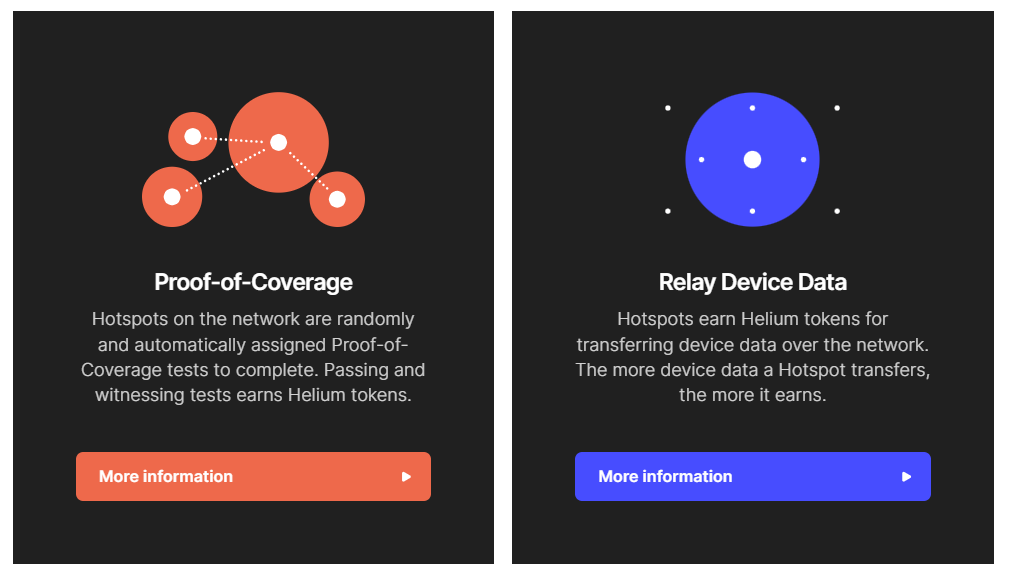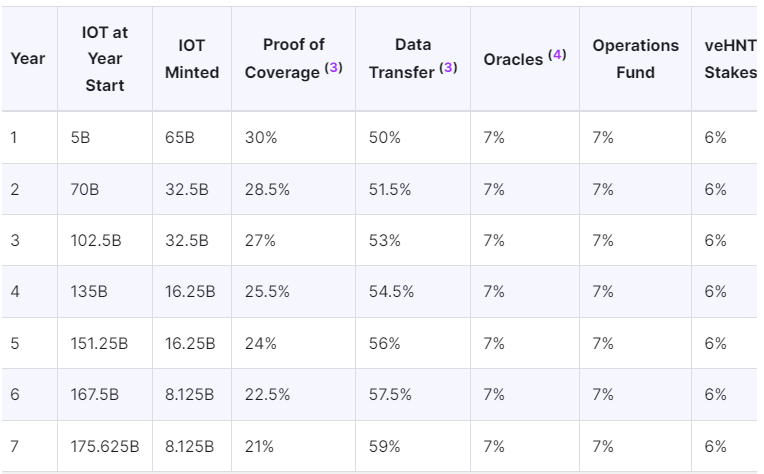
Helium Network Overview
Helium is an open-source blockchain network that aims to provide wireless connectivity to Internet of Things (IoT) devices. Built on the Solana Blockchain, its decentralized architecture relies on a network of devices known as Hotspots. These Hotspots act both as network miners and wireless access points, facilitating long-range communication for IoT devices and 5G networks.
The Hotspots are easy to deploy, allowing anyone to contribute to network expansion and earn IOT and MOBILE tokens in return. They connect to either 5G or the cloud via LoRaWAN, a media access control layer protocol, making it cost-effective to scale the infrastructure.
The network employs a unique consensus algorithm called Proof-of-Coverage (PoC), which rewards Hotspot operators for verifying the extent and quality of wireless coverage.
The network has recently migrated to the Solana network, therefore the previous NHT will no longer be minted and is totally redeemable to new IOT and MOBILE tokens.
How does Helium Work?
Helium takes a unique approach to blockchain technology by focusing not just on software but also on decentralizing physical hardware. The network achieves this through Hotspots, which are incentivized devices designed to extend internet coverage more affordably than traditional commercial options.
While Wi-Fi already supports Internet of Things (IoT) devices, it faces privacy concerns and limited range. Helium addresses these issues by using a decentralized structure combined with a novel consensus algorithm called Proof of Coverage (PoC). This approach offers up to 200 times the range of traditional Wi-Fi networks for IoT devices.
IoT refers to a system of interconnected physical devices equipped with sensors, software, and other technologies to exchange data. Devices under the IoT umbrella can range from smart fridges and electric scooters to medical devices and smart pet collars.

Source & Copyright Helium.com
In the Helium ecosystem, Hotspots serve a dual purpose: they function as nodes to facilitate data exchange among IoT devices and also secure the network by mining the native cryptocurrency IOT token. These devices are straightforward to set up, and once operational, they generate IOT tokens for the owner as a reward for enhancing network coverage and security.
The network's efficiency increases when Hotspots are in close proximity to each other. This not only boosts the network's density and range but also results in higher rewards for the hotspot owners. Helium utilized the LoRaWAN wireless protocol to extend connectivity up to 200 times the range of traditional WiFi.

Source & Copyright Helium.com
LoRaWAN, or Long Range Wide Area Network, is an open protocol that facilitates long-range communication among IoT devices, which could range from smart gadgets to industrial sensors. Because of its decentralized nature, Helium's network requires as few as 50-100 Hotspots to provide comprehensive coverage for an entire city.
Helium's PoC Consensus Algorithm
The Helium network operates on a novel consensus algorithm called Proof of Coverage (PoC), designed specifically for the network's requirements. This mechanism is combined with the Honey Badger Byzantine fault tolerance (HBBFT) protocol, ensuring consensus even in the presence of certain node failures.
Proof of Coverage incentivizes Hotspot Operators to deploy Hotspots in underserved areas and precisely report their deployments so Helium Network users can see where coverage is likely to be present.
Under PoC, hotspots are automatically and randomly tested to confirm they are providing the promised radio coverage at particular times and locations, with successful validations earning IOT rewards for the operators.

Source & Copyright Helium.com
Moreover, Hotspots can earn additional IOT tokens by transferring data across the network. The more data a Hotspot relays, the more IOT it earns. This model uses radio wave technology for mining, making it significantly less energy-intensive than traditional mining methods that rely on GPUs or ASICs.
Hotspots' Rewards
Ultimately, IOT rewards for hotspots are proportional to their contribution value within the Helium crypto ecosystem. There are three roles within the Helium ecosystem hotspots can perform to earn rewards:
Challenger: The challenger issues the challenge and verifies that the hotspots provide wireless coverage via the RF network at a particular location.
Beacon: The beacon, also referred to as the beaconer or challengee, which transmits the data package to other adjacent hotspots.
Witness: The surrounding hotspots that detect proof-of-coverage activity and report it to the challenger.
Helium 5G Hotspots
5G Hotspots enable wireless connectivity on the Helium 5G Network, predominantly serving cellular devices like mobile phones and tablets. Hotspots earn MOBILE tokens for their services, which can be redeemed to HNT directly through the Wallet App.
Helium 5G Hotspots utilize Citizens Broadband Radio Service (CBRS) Radios to deliver cellular coverage. Operating on a broad 3.5Ghz band, CBRS in the U.S. eliminates the need for Hotspot Hosts to obtain spectrum licenses. The Helium 5G network is currently only available in the U.S.
Data Credits
A key component in Helium's economic model is the use of Data Credits (DC). These credits function as the meium for transferring data across the network and also cover blockchain transaction fees. Data Credits are non-transferable and are tied to individual users or devices. They are generated by "burning" Helium tokens, thus creating a balance: as network usage and the demand for Data Credits increase, more Helium tokens are removed from circulation.
In the Helium ecosystem, Data Credits are essential for any device that wishes to transmit data to the internet. They are set at a fixed value, equivalent to $0.00001 USD each, ensuring stable transaction costs for users and developers. Because Data Credits are user-specific and non-exchangeable, they resemble mobile minutes in a prepaid phone plan. They are exclusively used for network services and cannot be traded.
IOT Token
IOT serves as both the incentive and governance token for the Helium Network, acting as the fuel that drives the entire ecosystem. It's awarded to Hotspots that contribute to the network by providing and validating wireless coverage as well as enabling internet connectivity for devices.
IOT was introduced via the community-led initiative HIP-52. The first batch of IOT tokens was created following the network's migration to the Solana blockchain on April 18, 2023.
IOT tokens are intrinsically linked to HNT tokens, with a conversion mechanism in place. This conversion is facilitated through a pool of HNT allocated to each sub-network within the Helium ecosystem, determined by its Network Utility Score. The exchange rate between IOT and HNT is algorithmically set by treasury swap contracts, based on this utility score.
For those looking to convert IOT to HNT, the primary platform is the Helium Wallet App. Additionally, this conversion can be executed directly on the Solana blockchain using the open-source tools available in Helium's GitHub repositories.
In terms of supply, IOT follows a minting schedule similar to that of HNT but has a maximum cap of 200 billion tokens. The initial year for IOT began on August 1, 2022, and its issuance is planned to undergo halvings every two years, mirroring the halving schedule of HNT.

Source & Copyright Helium.com
MOBILE Token
The MOBILE token is mined by 5G Hotspots through both data transfer proceeds as well as Proof of Coverage. Just like IOT, MOBILE is redeemable to HNT. To facilitate this, a specific HNT pool is set aside for each network in the Helium Network, determined by the Network Utility Score. The conversion rate between MOBILE and HNT is algorithmically determined by the treasury swap agreements, reflecting the Network Utility Score.
MOBILE token follows a minting schedule similar to HNT, with a maximum supply of 230 billion (230,000,000,000) tokens. Out of this, 50 billion MOBILE tokens were pre-mined during the Mobile Network's launch and allocated to the Network operations fund managed by the Helium Foundation. A portion of this allocation was distributed to active Mobile Network Hotspots during the Genesis period. The first year for MOBILE began on August 1st, 2022.
The issuance of MOBILE tokens is planned to undergo halvings every 2 years, coinciding with the halving schedule of HNT issuance.

Source & Copyright Helium.com
Team and Investments
Established in 2013 by Amir Haleem, a former competitive video gamer, and Shawn Fanning, renowned for creating Napster, Helium initially aimed to build an expansive wireless network tailored for the emerging world of low-power, low-cost sensors. Before the concept of the Internet of Things (IoT) gained traction, the duo foresaw the proliferation of miniature sensors in a multitude of devices, from home appliances to inventory management systems. They recognized the universal need for these devices to have an affordable, energy-efficient way to connect to the internet.
By 2014, the founders had refined their vision, focusing on creating a decentralized mesh network comprised of millions of hotspots. These hotspots would function like wireless signal repeaters, connecting to each other to extend coverage. Instead of relying on costly and large cellular towers, a community of volunteers would host these compact, cost-effective mini towers, creating a more democratic network infrastructure.
Operating under the parent company Helium Inc., headquartered in San Francisco, the network launched in 2019 with the mission to address key challenges in IoT, including privacy concerns. Co-founded by Amir Haleem, Sean Carey, and Shawn Fanning, the venture garnered over $53 million through four rounds of funding between 2015 and 2019. Notably, the Series A round raised $16 million from backers such as Khosla Ventures and FirstMark Capital, while the Series B round generated $20 million, with participation from GV (formerly Google Ventures) and other existing investors.
On March 30, 2022, the company underwent a rebranding as Nova Labs, following a $200 million Series D investment led by venture capital firms Andreessen Horowitz (a16z) and Tiger Global.
Where Can You Buy IOT and MOBILE?
Currently IOT can be purchased solely on two Solana decentralized exchanges: Raydium and Orca.
FAQ
What is the Helium Network?
The Helium Network is a decentralized, global system of Hotspots that furnish extensive wireless connectivity for Internet of Things (IoT) devices. These Hotspots earn rewards in the form of IOT, a digital currency that operates on the Solana blockchain.
Why is it referred to as The People's Network?
It's dubbed The People's Network because individual users who deploy Hotspots are responsible for constructing and maintaining the network. Thus, it's a network that is both generated and owned by its community members.
How do Hotspots function and what devices do they support? Hotspots allow individuals to establish and manage their own wireless network that can accommodate a broad spectrum of IoT gadgets. This includes everything from smart collars for pets and automated delivery systems, to intelligent bicycles and scooters, medical tracking equipment, climate control systems, smart lighting solutions, and much more.
Will Helium substitute my home Wi-Fi?
No, Helium Hotspots don't replace your home Wi-Fi. They collect and forward data packets from local low-power devices that operate on the LoRaWAN wireless protocol and are connected to the Helium Network. These devices often include things like GPS trackers, environmental sensors, or weather gauges that need to send only small amounts of data. The Hotspot uses your existing internet connection, via Wi-Fi or Ethernet, to transmit this information but does not replace traditional internet or cellular services for general-use devices like computers or smartphones.
How do Hotspots generate IOT?
Hotspots accumulate IOT tokens by offering wireless coverage and transmitting data from devices in close proximity. The greater the volume of data transferred, the larger the IOT reward. In the past, Hotspots earned HNT tokens.
What exactly are Data Credits?
Data Credits are non-exchangeable tokens that serve as the sole means of payment for operations on the network. In addition to covering blockchain transaction costs, these credits can be utilized to send data packets over Helium Network.










